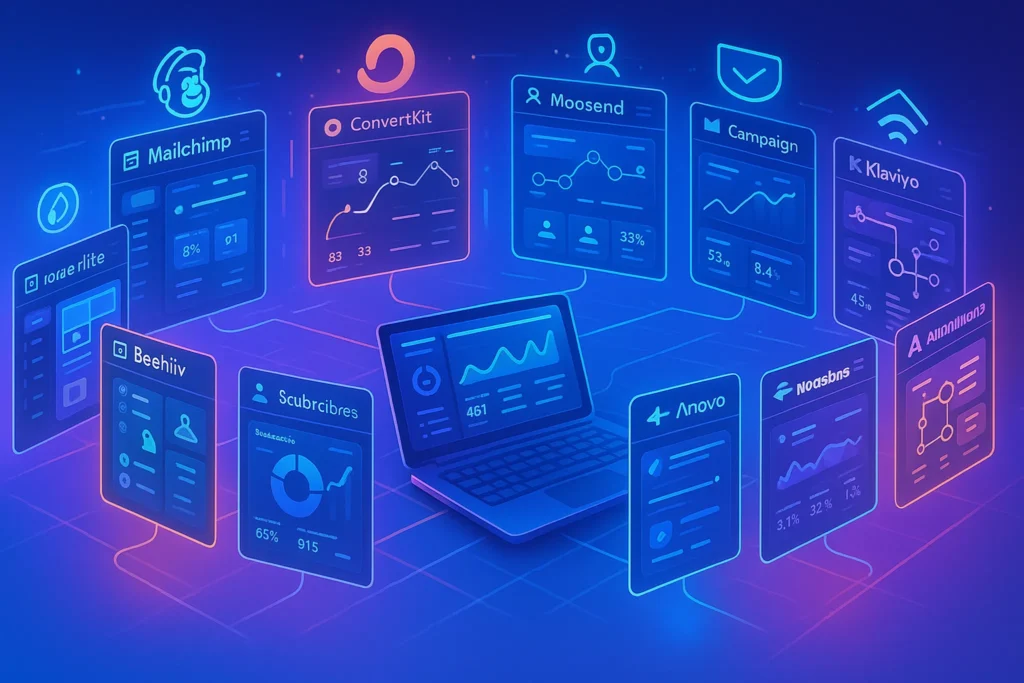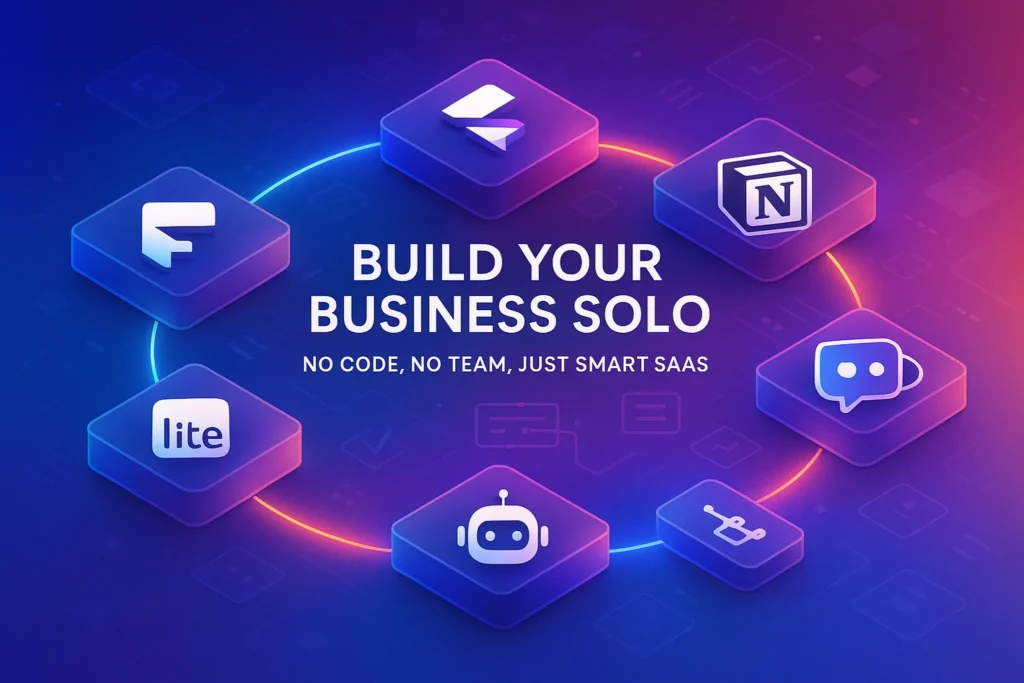-This post may contain affiliate links. If you click on one and make a purchase, I may earn a small commission at no extra cost to you.-
📩 Intro: Email Still Rules
In a world filled with flashy social platforms and short-lived trends, one thing remains true: email marketing still delivers the highest ROI. According to Litmus and HubSpot, the average email campaign generates a staggering $36–$42 for every $1 spent—that’s a 3600%+ return.
But not all email platforms are created equal. Some are great for beginners, others shine in automation, while a few are optimized for creators or eCommerce businesses.
In this post, we compare 10 of the best email marketing tools for 2025—based on features, pricing, and real-world use cases. Whether you’re launching your first newsletter or automating a sales funnel, this guide will help you find the right tool for your goals.
📬 1. Mailchimp
One of the most recognizable names in email marketing, Mailchimp remains a strong choice—especially for beginners. Its intuitive drag-and-drop builder, visual journey automation, and strong brand reputation make it a go-to for startups.
Mailchimp offers a well-rounded platform ideal for beginners who want to get started with newsletters and simple automation quickly. Beyond email, it also includes a basic website builder, content studio, and survey tools, which makes it more than just an email service—especially helpful for small or local businesses just going digital. For teams that need all-in-one simplicity and decent branding options out of the box, Mailchimp still delivers excellent value.
🔍 Key Features:
-
Easy-to-use email editor
-
Pre-built automation workflows
-
Basic audience segmentation and analytics
💸 Pricing:
-
Free for up to 500 contacts
-
Paid plans start at $13/month
💡 Best For:
-
Startups, personal brands, offline businesses going digital
Mailchimp is also often featured in beginner email list-building courses, including our guide: Ultimate Guide to Building an Email List with AI Tools.
📨 2. Brevo (formerly Sendinblue)
Rebranded but still powerful, Brevo offers marketing + transactional emails, making it a unique hybrid. You can manage newsletters and send OTPs or receipts all from one platform.
Brevo stands out because it supports both transactional and marketing emails under one roof, making it ideal for businesses that need to send order confirmations, password resets, and newsletters from the same platform. Its built-in CRM, advanced contact segmentation, and SMS campaign features make it one of the most versatile tools—particularly for brands operating in Europe, where data compliance and privacy are non-negotiable. Brevo is also scalable for SaaS and local service providers alike.
🔍 Key Features:
-
Visual automation builder
-
SMS marketing
-
Unlimited contacts with daily send limits
💸 Pricing:
-
Free plan: 300 emails/day
-
Paid starts at $25/month for higher volume
💡 Best For:
-
EU-based businesses (GDPR strong compliance), SaaS apps, local brands
If your business requires both marketing and transactional outreach, Brevo offers rare versatility for the price.
📬 3. ConvertKit
Designed specifically for creators, ConvertKit helps bloggers, podcasters, and solopreneurs grow audiences with tag-based segmentation, beautiful landing pages, and visual sequences.
ConvertKit is built with creators in mind—and it shows. Whether you’re a blogger, podcaster, author, or YouTuber, the platform gives you everything you need to nurture leads and sell digital products directly via email. With features like smart tagging, trigger-based sequences, and integrations with platforms like Teachable and Gumroad, ConvertKit creates highly personalized journeys. Their new Creator Network even helps users grow their lists through organic promotion.
🔍 Key Features:
-
Smart subscriber tagging
-
Email sequences
-
Prebuilt forms + embeddable landing pages
💸 Pricing:
-
Free for up to 1,000 subscribers
-
Paid from $15/month
💡 Best For:
-
Bloggers, authors, course creators, YouTubers
ConvertKit has been the backbone of many creator-first funnels, including examples featured in AI Tools to Launch a Blog.
🧠 4. GetResponse
GetResponse isn’t just an email platform—it’s a full marketing ecosystem. With features like webinar hosting, lead scoring, and built-in sales funnels, it’s great for eCommerce, coaches, and course creators who want to run campaigns without juggling multiple tools. GetResponse also includes eCommerce-specific automation triggers like abandoned cart, purchase history, and product recommendations, helping you optimize for conversions at every step.
If you’re looking for advanced automation + webinar hosting, GetResponse delivers. With a powerful autoresponder engine and built-in sales funnels, it’s a great fit for growing email lists and eCommerce stores.
🔍 Key Features:
-
Advanced automation
-
Built-in funnel builder
-
Landing pages + A/B testing
💸 Pricing:
-
Free for 500 contacts
-
Paid plans from $19/month
💡 Best For:
-
eCommerce, info-product sellers, agencies
📨 5. MailerLite
MailerLite shines in its simplicity and clarity. It has one of the cleanest user interfaces among email tools, making it extremely approachable for beginners. Despite its minimalist feel, it offers landing pages, signup forms, and basic automation—all with drag-and-drop ease. It even includes a website builder and survey functionality at no extra cost, making it a powerful choice for freelancers or early-stage solopreneurs looking to move fast on a budget.
Simple, lightweight, and surprisingly powerful. MailerLite is perfect if you need no-frills email marketing with clean UX.
🔍 Key Features:
-
Visual campaign builder
-
Automation, tagging
-
Survey forms, landing pages
💸 Pricing:
-
Free up to 1,000 subscribers
-
Paid from $10/month
💡 Best For:
-
Solopreneurs, coaches, minimalists
🆚 MailerLite vs. ConvertKit?
If you’re just starting and want simplicity, MailerLite wins. But if you need advanced sequences and deeper automation, ConvertKit has the edge.
📬 6. Moosend
Moosend brings a lot of power under a lightweight interface. It features AI-driven automation, including predictive segmentation, product recommendations, and even weather-based triggers for campaigns—capabilities usually reserved for much more expensive tools. This makes Moosend an excellent choice for small to medium-sized eCommerce brands who want to personalize their campaigns without breaking the bank.
Don’t let the simple UI fool you. Moosend packs AI-powered features like predictive segmentation and product recommendations—making it ideal for small eCommerce operations.
🔍 Key Features:
-
Smart automation triggers
-
AI segmentation
-
Real-time analytics
💸 Pricing:
-
Free trial only
-
Paid from $9/month
💡 Best For:
-
Affordable automation with AI perks
📨 7. Benchmark Email
Benchmark is all about speed and usability. It’s designed for marketers who want to get emails out the door without overthinking. Its real-time editing interface, mobile-ready templates, and A/B testing tools help small teams launch polished campaigns in minutes. While it doesn’t offer deep automation, it’s an ideal solution for quick promotions, event invites, or flash sales where simplicity trumps complexity.
Speed and simplicity define Benchmark Email. Its real strength lies in quick campaign creation, thanks to responsive templates and a smooth editor.
🔍 Key Features:
-
Clean UX
-
Drag-and-drop builder
-
A/B testing, autoresponders
💸 Pricing:
-
Free plan: 500 emails/month
-
Paid from $13/month
💡 Best For:
-
Small teams, fast-turnaround marketers
📬 8. AWeber
AWeber has been a trusted name in email marketing for over two decades—and for good reason. It delivers consistent email deliverability, solid list management, and autoresponder sequences that just work. The platform now also supports push notifications, landing pages, and simple eCommerce integrations. It’s particularly well-suited for those who prioritize stability, legacy support, and responsive customer service.
A staple in the industry, AWeber has been around since 1998 and remains a solid choice for reliable deliverability and basic automation.
🔍 Key Features:
-
Drag & drop email builder
-
Pre-built templates
-
Basic split testing
💸 Pricing:
-
Free for up to 500 subscribers
-
Paid from $14.99/month
💡 Best For:
-
Businesses looking for stability, classic email marketing
📨 9. Campaign Monitor
Campaign Monitor is a favorite among designers and agencies thanks to its stunning templates and pixel-perfect editor. It offers dynamic content blocks, which allow you to show different content to different segments within the same campaign. Combined with their analytics dashboards, Campaign Monitor becomes a strategic tool for data-driven creatives who want both form and function. It’s perfect for agencies managing campaigns across multiple client brands.
If visual polish and beautiful emails are your priority, Campaign Monitor is unmatched. Their template gallery is the best in the industry.
🔍 Key Features:
-
Professional email templates
-
Dynamic content blocks
-
Visual journey mapping
💸 Pricing:
-
No free plan
-
Paid from $9/month (based on volume)
💡 Best For:
-
Design-heavy brands, agencies
📬 10. Drip
Drip is engineered for eCommerce automation at scale. It deeply integrates with platforms like Shopify, WooCommerce, and custom carts, allowing store owners to create workflows based on detailed behaviors like product views, cart abandonment, and purchase frequency. It also offers revenue attribution, so you can measure the exact ROI of each campaign. For DTC brands or advanced Shopify stores, Drip offers a serious competitive edge.
Built for eCommerce, Drip is laser-focused on behavioral email triggers, purchase history segmentation, and integrating with platforms like Shopify and WooCommerce.
🔍 Key Features:
-
Event-based workflows
-
Revenue dashboards
-
Deep eCommerce integrations
💸 Pricing:
-
No free plan
-
Paid from $39/month (based on list size)
💡 Best For:
-
Shopify sellers, eCommerce marketers
🧮 📊 Feature Comparison Table (FVL)
| Tool | Free Plan | Automation | Landing Pages | Best For |
|---|---|---|---|---|
| Mailchimp | ✅ | Basic | ✅ | Beginners, Startups |
| Brevo | ✅ | Yes | ✅ | EU Businesses, SaaS |
| ConvertKit | ✅ | Advanced | ✅ | Bloggers |
| GetResponse | ✅ | Strong | ✅ | eCommerce, Funnels |
| MailerLite | ✅ | Moderate | ✅ | Solopreneurs |
| Moosend | ❌ (Trial) | Smart AI | ✅ | Affordable Automation |
| Benchmark | ✅ | Moderate | ❌ | Speedy Campaigns |
| AWeber | ✅ | Basic | ✅ | Classic Email Marketing |
| CampaignMonitor | ❌ | Yes | ✅ | Design-Focused Campaigns |
| Drip | ❌ | Advanced | ❌ | eCommerce |
🧠 Choosing the Right Tool: What Actually Matters?
With so many email marketing platforms out there, it’s easy to get overwhelmed by features, pricing tiers, and flashy dashboards. But what truly separates a useful tool from a waste of budget? Here are the five core factors you should consider before deciding:
1. Deliverability
It doesn’t matter how beautiful your email looks—if it ends up in the spam folder, it’s worthless. Look for platforms with strong IP reputation, custom domain authentication (SPF/DKIM), and deliverability transparency.
2. Ease of Use
If you’re a solo founder or small team, you don’t have time to learn a complex system. Choose a platform with an intuitive UI, drag-and-drop builders, and pre-built automations—especially if you’re new to the space.
3. Automation Capabilities
Not all automation is created equal. Some tools offer basic autoresponders, while others like ConvertKit and GetResponse let you create branching logic, score leads, and trigger emails based on purchase or behavior.
4. Affiliate Marketing Support
Some platforms limit affiliate links—or disallow them altogether. If you’re planning to monetize through affiliate funnels, confirm that the platform’s policy aligns with your goals. (This is why ConvertKit and AWeber stand out.)
5. Scalability
Think beyond today. Will this tool still work when your list grows to 10k or 50k subscribers? How does pricing scale? Is support responsive? Can you switch without losing your automations?
If you’re still unsure, check our related post on AI Tools to Launch a Blog, which includes tools to pair with your email platform for smarter growth.
🔍 How We Evaluated These Tools (Testing Methodology)
You might be wondering—how did we come up with this list?
We didn’t just rely on feature charts or affiliate rankings. Each tool was tested in real-world use cases, and scored across five dimensions:
🔧 1. Setup Experience
We created an account from scratch to see how intuitive the onboarding process was—especially for beginners.
🧪 2. Email Creation & Templates
We tested drag-and-drop editors, template variety, and mobile responsiveness to evaluate speed and quality of campaign creation.
🧠 3. Automation & Segmentation
We built workflows (e.g., welcome series, cart abandonment, re-engagement) to assess the depth and flexibility of automation logic.
📬 4. Deliverability
Using authenticated test domains, we sent real emails to sample Gmail, Yahoo, and Outlook accounts to measure inbox placement and bounce rates.
💼 5. Affiliate Suitability
We reviewed each platform’s terms of use and spam policies to ensure they allow affiliate links and support email monetization models.
This hands-on approach ensured we weren’t just parroting marketing claims—we evaluated based on what actually works for creators, solopreneurs, and small teams.
🔮 What’s Next for Email Marketing in 2025?
Email is evolving—and fast. If you’re planning for long-term growth, it’s worth understanding where the industry is headed. Here are key trends we’re watching:
🤖 1. AI-Powered Personalization
Beyond “Hello [First Name]”, expect tools to generate subject lines, content blocks, and even predictive offers based on subscriber behavior. GPT-style tools are being integrated into platforms like ConvertKit and GetResponse.
🧠 2. Smarter Segmentation
Behavioral segmentation is becoming automated. Expect platforms to auto-tag users based on opens, link clicks, time-of-day engagement, or even product affinity—no manual work required.
📨 3. Inbox Filtering Will Get Tougher
As Gmail and Apple Mail tighten filtering standards, quality scores and user engagement (open, click, reply) will matter more than ever. Keeping a clean list and sending relevant content will be critical.
🔄 4. Lifecycle Automation
Static sequences are being replaced by lifecycle flows that adjust to subscriber behavior over time. Think: different emails if someone opens early in the morning vs. late at night.
📦 5. Native Monetization
Platforms like ConvertKit are moving toward built-in product sales, newsletters with paid subscriptions, and micro-donations—letting creators earn directly without third-party platforms.
Email in 2025 will be more dynamic, more contextual, and more monetizable than ever.
⚠️ Common Pitfalls to Avoid in Email Marketing
Even the best platform won’t help if your strategy is flawed. Here are some of the most common mistakes we’ve seen—and how to avoid them:
❌ 1. Using Free Plans Without Warming Up
Jumping straight into mass email campaigns from a new domain/IP? You’ll likely get flagged as spam. Start slow. Warm up your sender reputation before scaling.
❌ 2. Ignoring List Hygiene
Holding on to disengaged or invalid subscribers will hurt your open rates and deliverability. Clean your list regularly using bounce filters and engagement metrics.
❌ 3. Over-Automating
Yes, automation is powerful—but it can backfire if it feels robotic or irrelevant. Always review flows from the subscriber’s perspective.
❌ 4. Using Affiliate Links Without Cloaking/Context
If you’re doing affiliate marketing, don’t just drop a raw link. Add value. Explain why the tool matters. Use redirect URLs where allowed to track performance and build trust.
❌ 5. Neglecting Mobile Optimization
Over 50% of email opens happen on mobile. If your emails aren’t optimized for small screens, expect high bounce and low engagement—even if your offer is great.
💼 Use-Case Layering
-
Solopreneur, tight budget? → MailerLite or ConvertKit
-
eCommerce automation needed? → GetResponse or Drip
-
Design-focused brand? → Campaign Monitor
-
Just starting out? → Mailchimp or AWeber
-
Want hybrid marketing + transactional emails? → Brevo
🧠 Nerd Verdict
There is no “best” email marketing platform—only the best fit for your business.
If you’re just starting out, free tools like MailerLite or Mailchimp help get off the ground. For automation-heavy or monetized funnels, ConvertKit, GetResponse, and Drip offer scalable power.
Before choosing, ask yourself:
-
How big is my list?
-
How complex are my automations?
-
Do I prioritize speed, design, or segmentation?
The right answer is the one that fits your workflow—not just your budget.
❓ FAQ: Nerds Ask, We Answer
💬 Would You Bite?
If you could only use one email platform for the next 3 years, which one would you choose—and why?
👇 Drop your experiences, complaints, or hidden gems in the comments.



